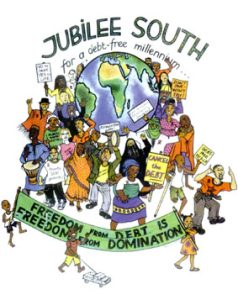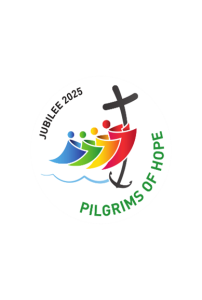By Joe Gunn

Opening the doors of St. Peter’s Basilica in Rome at the midnight Mass on Christmas Eve 2024, Pope Francis launched the Jubilee Year 2025. The symbolic gesture indicated that this pope wants Jubilee commemorations to move beyond prayer in our churches – he’s calling us to step out into specific actions in global societies.
Under the theme “Pilgrims of Hope,” perhaps 35 million devout visitors will descend upon Rome throughout the year, in search of a promised plenary indulgence. But Francis hopes Christians will also promote peacebuilding in a world threatened by climate change and wars. The Pontiff urged nations to eliminate the death penalty and to cancel debts of countries of the Global South.
Some readers of a certain age might remember the Jubilee Year 2000, which also highlighted campaigns to cancel odious debts of poor countries. What did we learn back then? And what must we do differently – or better – in 2025, if we are to achieve more lasting results?
Memories of Jubilee 2000

Launched in March 1997, the Canadian Ecumenical Jubilee Initiative (CEJI) had enough time to ramp up effective research, education and advocacy strategies before the new millennium. Resonating with the biblical texts of Leviticus 25: 10-17, we agreed on three prominent Jubilee themes: Release from Bondage, Redistribution of Wealth, and Renewal of the Earth. Although best remembered for impactful campaigning on the international debt issue, CEJI also campaigned subsequently on child poverty in Canada, restoring land to Indigenous peoples and climate change.
CEJI established a Working Group to coordinate activities and strategies. It was based in the centre of the Canadian ecumenical universe… remember: at that time there were a dozen ecumenical coalitions funded by the major Christian churches… all but two were located in Toronto. Because we eventually brought together 37 member organizations, it was seen to be necessary to convene every meeting somewhere on the Toronto Transit system. In those days, as the Director of the Social Affairs Desk of the Canadian Conference of Catholic Bishops, I was often the guy who traveled the furthest; these almost monthly trips to “the Canadian Mecca” resulted in important relationship-building.
CEJI established a Vision Statement early in our work, which served as a unifying force in all the campaigns. A bilingual theology conference was organized in Montreal – it was one of the very few national initiatives hosted outside of Toronto – if memory serves, at the Congregation de Notre Dame convent on rue Sherbrooke. A theology committee published three books. These were not all theoretical pieces – some entries were sermons delivered by different preachers in language any congregant could understand.
And CEJI’s educational work was unprecedented: some 350,000 pamphlets on debt issues were circulated, and 120,400 educational posters distributed (almost 1 for every church in Canada!). Some 16,185 leadership guides were also provided to activists; 114 communities intentionally pledged themselves to be “Jubilee communities.”
Over 640,000 signatures were affixed to our petition calling for the cancelation of international debts – in those early-Internet days, it was the largest hard copy petition in Canadian history!
Strategically, we recognized early on that such an international campaign should not be led by activists in the Global North. CEJI helped finance meetings between southern activists, who eventually established “Jubilee South” and pushed for much more radical, just responses from the World Bank and International Monetary Fund. The Canadian campaign worked in tandem with leaders like Nicaragua’s Alejandro Bendana, whom I had known as Director General of that country’s Foreign Ministry. Ale holds a PhD from Harvard and was comfortable doing several speaking tours in Canada, coming to CEJI meetings, visiting Members of Parliament and having long chats into the night at our home.
By listening to the voices of those most affected by onerous debt repayment schemes that were demanded of the “Least Developed Countries” CEJI rejected the “Highly-Indebted Poor Country Initiative (HIPC)” of the powerful international finance institutions. The HIPC Initiative promised debt “relief” – not cancellation. And the measures were accompanied by various forms of conditionality known as “structural adjustment programs” (SAPs). For example, to renegotiate its debt, Uganda was forced to privatize its potable water services – hardly a benefit for the poor.

So while the international campaign resulted in $100 billion in debt “relief” it is no surprise that here we are two and half decades later, facing the on-going debt crisis that Pope Francis has denounced. “…to break the bonds of injustice and to proclaim God’s justice. Sporadic acts of philanthropy are not enough. Cultural and structural changes are necessary, so that enduring change may come about.” Wealthy lenders were allowed to set the conditions of loans and their repayment – at gain to themselves. A periodic Jubilee cannot be successful if the rules remain exploitative of the poor.
I vividly remember delivering a sermon on the Jubilee call for debt cancelation in a church one Sunday. Before leaving the altar, the priest addressed the congregation: “I don’t know if you noticed, but the Finance Minister was at Mass this morning.” After hesitating for effect, the pastor continued: “Well, he’s gone from the back row now, but you can be sure he got our message!”
Advocacy for change can be done in many ways!
CEJI Working Group member Jennifer Henry recounts a related “famous story” of those times. Apparently, Finance Minister Paul Martin used to say he “couldn’t go into a church in Canada during that period without being buttonholed about the debt issue.” She goes on to explain “What was striking about that was that the Finance Minister of Britain was experiencing the same thing. They would show up at the G8 meetings together with this collective pressure. And so what happened, due to this combination of lobbying, policy analysis and grassroots engagement, was that we got 100% bilateral debt cancellation from Canada, and we moved some benchmarks globally.”

Essential to our efforts was getting the mainstream media to reproduce CEJI’s messages. I recall driving to Toronto with our children, planning to celebrate Christmas with my aging parents. But CBC Radio called, and off I sped to do an interview with the lovely host, Shelagh Rogers, who was quite interested in international debt issues herself. (I remember telling of how health spending was less than debt repayment in Nicaragua, where I knew of pregnant moms forced to sleep two to a bed in hospitals, and rely on their families to bring them food.) Later, a bishop in Nova Scotia wrote to tell me how pleased he was to hear the interview – and here I had thought all bishops spent Sunday mornings in church!
Jubilee 2025 Anticipation

There are going to be some substantial differences between the activities carried out in 2000 and what we might be able to achieve in 2025.
While we were once invited to meet with Finance Ministers like Paul Martin and Ralph Goodale for pre-budget conversations, two substantial things have changed. It is not at all clear that the churches have undertaken the preliminary and necessary research into current Canadian policies related to international debt issues. Added to this, the political situation on Parliament Hill is extremely unstable as we enter the new year. While we can all promote the international petition on debt cancelation, there is no specific Canadian text in 2025. We have more work to do…
Also, the situation of indebtedness has changed – more debt is now being held by private investors, as opposed to governments and international institutions. Different campaign targets are necessary to bring impactful results.
And different from 2000, ecological debt is an issue that has today achieved international attention. Many poorer countries and peoples are facing a climate crisis they did little to create. November’s COP29 in Baku failed to obtain commitments to reach the target of $1.3 trillion in climate financing – imagine what international debt negotiations will obtain. Since wealthy countries did commit to raise $300 billion annually by 2035 for climate financing, requests for substantial action on debt financing may face strong headwinds.
Nonetheless, Canadian church activists recall that we did have some successes in 2000. After what seemed like endless discussions perhaps, we did achieve common analyses and agreements. We saw that campaigns succeed best at bringing faith-based communities together when they are theologically based. We also learned we need multiyear campaigns, with perhaps a year of preparation for research and production of educational materials – a successful campaign cannot just end in 2025. Surely successful campaigning today will be more electronic than our work a quarter decade ago. And like before, we must develop campaigns that are led by insightful voices of advocates – not just victims – working in the Global South. We cannot assume we are the architects of their liberation.
A broad commitment of many actors to a Jubilee 2025 campaign could be an energizing way to allow faith communities to collaborate on a series of focussed actions. It has been done before, but as Isaiah 43:19 challenges us, “I am doing a new thing; do you not see it? …now it springs up. Do you not perceive it?”
After all, there are some lessons to learn if we hope to avoid repeating the same calls to action in 2050!
